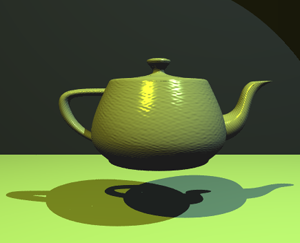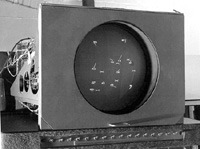Teaching:TUW - UE InfoVis WS 2007/08 - Gruppe 09 - Aufgabe 1 - Computer Graphics

Definition[edit]
Subfields[edit]
Computer Graphics may be divided into four major categories:
Geometry[edit]
The subfield of Geometry studies ways to represent and process surfaces. Boundary representations are most commonly used, because the appearance of an object depends mainly on its exterior. Although point-based representations have been getting more and more popular lately, polygonal meshes are still the most popular form of discrete digital approximation of surfaces. These representations are Lagrangian (the spatial locations of the samples are independent) as opposed to Eulerian surface descriptions (i.e., where spatial samples are fixed) which are mainly used for deforming surfaces which undergo many topological changes (e.g. fluids). A subfield of Geometry called Imaging studies the process of image acquisition and image editing.
Animation[edit]
This subfield of Geometry studies ways to represent and manipulate motion. Historically most interest has been focused on parametric and data-driven models, but in recent years physical simulation has experienced a renaissance due to the growing computational capacity of modern machines.
Rendering[edit]
This subfield of Geometry studies algorithms to reproduce light transport. It does so by converting a model into an image by simulating light transport to get physically-based photorealistic images, or by applying a style as in non-photorealistic rendering. Two basic operations in realistic rendering are transport (how much light gets from one place to another) and scattering (how surfaces interact with light).
History[edit]

In the 60's, Jack Bresenham published how to draw lines on a raster device. He later extended this to circles. Larry Roberts pointed out the usefulness of homogeneous coordinates, 4x4 matrices and hidden line detection algorithms. Steve Coons introduced parametric surfaces and developed early computer aided geometric design concepts. The earlier work of Pierre Bézier on parametric curves and surfaces also became public.
In the 70's, rendering (shading) was discovered by Gouraud and Phong at the University of Utah. Turned Whitted developed recursive ray tracing which became the standard for photorealism. One of the first displays of computer animation was Futureworld (1976), which included an animation of a human face and hand — produced by Ed Catmull and Fred Parke also at the University of Utah.
In the 80's, Jim Blinn introduced blobby models and texture mapping concepts. Binary space partitioning (BSP) trees were introduced as a data structure. Loren Carpenter started exploring fractals in computer graphics. Postscript was developed by John Warnock.Steve Cook introduced stochastic sampling to ray tracing. Video arcade games took off.
In the 90's, Mosaic, the first graphical Internet browser was written. OpenGL became the standard for graphics APIs.Dynamical systems (physically based modeling) that allowed animation with collisions, gravity, friction, and cause and effects were introduced. Surface subdivision algorithms were rediscovered. Wavelets begin to be used in computer graphics. Image based rendering became the area for research in photo-realistic graphics.
Application[edit]

- graphs and charts
- computer-aided design
- virtual-reality environment
- data visualisation
- education and training
- computer art
- entertainment
- image processing
- graphical user interfaces
External links[edit]
Futureworld at the Internet Movie Database
ACM SIGGRAPH
References[edit]
[Fetter, 1966] W. A. Fetter, Computer Graphics in Communication, McGraw-Hill Book Company, New York, 1965.
[Goodchild, 2007] T. Goodchild, Wikipedia, Computer Graphics. Retrieved at: November 8, 2007. http://en.wikipedia.org/wiki/Computer_graphics.